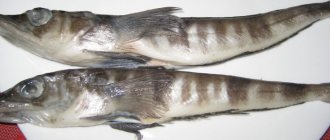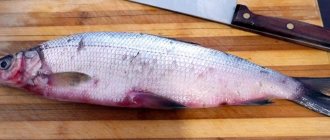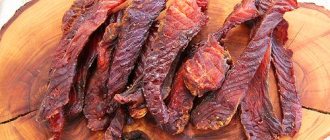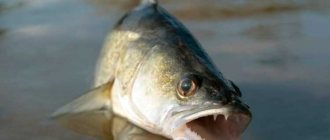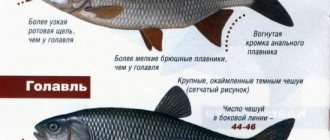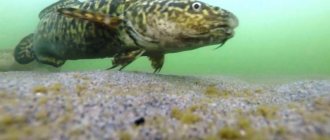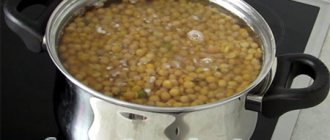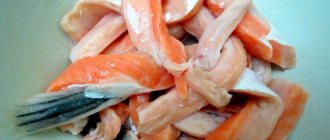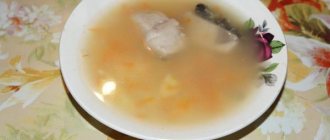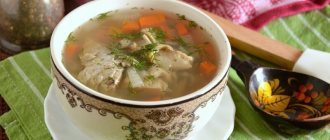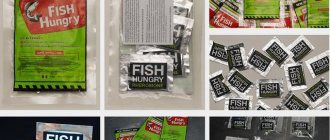What kind of fish is navaga - description and photo
Navaga is also called “vahnya”. The length of this sea creature reaches 30-40 cm. The average weight is 500 grams. The basis of the navaga’s diet is fry and all kinds of mollusks.
This valuable fish is a fishery object. It is often caught by trawls and seines. Amateur fishermen also hunt navaga. At the same time, they mainly practice ice fishing.
The taste of navaga is significantly superior to other representatives of the Cod family. It is characterized by tender meat, which has a pleasant taste and contains many nutritional components.
Fishing for navaga is practiced in most cases from ice
Varieties
There are 2 main types of navaga:
- Northern - lives in the White, Barents, Kara seas. It has tender meat. It was this species that was the first to be harvested on a large scale. The fish is smaller - its length is 30 cm. This variety of navaga is characterized by excellent taste and benefits for the body.
- Far Eastern navaga – it is also called vakhnya. This fish is larger in size compared to the northern one. It is found in the northern waters of the Pacific Ocean - in the Bering and Chukchi Seas. The fish also lives in Far Eastern reservoirs - these include, in particular, the Seas of Japan and the Sea of Okhotsk.
In general, the taste qualities of these species are similar. At the same time, the best taste is typical for fish that was caught in winter or late autumn.
Difference from similar fish
Navaga resembles cod in appearance. However, there are certain features that help distinguish these types of fish. Navaga has a more rounded body, which tapers from the head towards the tail. She also has a small head and unusual extensions on her spine. On the back of the fish there are 3 fins of a dirty green hue, covered with small spots.
The sides of the navaga have a silver-violet color, and the belly has a white tint. Another distinctive feature is the protruding upper jaw. At the same time, there is a mustache on the bottom of it. The size of the fish does not exceed 50 cm.
Cod
Navaga
Fishing for navaga
To start fishing, you need to choose the right set of gear.
These include:
- Fishing rod
- Various baits
- Mormyshka
- Components: fishing line, reel, hooks, spinner
- Bait
Winter fishing is significantly different from summer fishing. To do this, you will need a fishing rod, and definitely a drill (for drilling holes). In winter, fish of this species live near the seashore.
The fishing rod should have a line about 50 meters long and 0.4 mm thick. In some cases, fishing enthusiasts fish with 2 or 3 spoons. In this case, one fishing rod is used, and the baits are evenly spaced half a meter apart.
Usually, bait is not used for predatory fish species. But for catching navaga, it will become very effective. To prepare it, you should take potatoes boiled in their jackets and a package of krill. Mash everything well.
Having caught 237 kg of fish, the poachers were not punished!
During interrogation, the detained fishermen revealed the name of the secret bait.
Place the bait in a fabric bag, tie it and lower it into the water. The smell of the treat will attract fish and you can start fishing. You can fish using jigs, spinners and other various baits.
Fishing places
You can fish in almost all its habitats on all coasts. As experienced fishermen have noticed, the best and most active bite occurs in winter.
Fishermen prepare holes on the ice of the reservoir (preferably 3 at a time) and begin ice fishing. On all coasts where navaga lives, fishermen use homemade fishing rods (pullers). This name does not characterize the name of the fishing equipment, but the fishing method.
Spawning
The vakhna reaches sexual maturity at 3 years of age. In summer, the fish go to a depth of 40-60 meters, and with the onset of cold weather, schools head to the shores for the purpose of reproduction. Sometimes it enters the mouths of rivers and lakes that communicate with the seas.
For spawning, navaga requires areas with strong ebbs and flows. Rocky and pebble soil types are best suited for this. Sometimes she chooses a sandy bottom. In this case, the fish attaches eggs to underwater objects.
Interesting to know! Navaga begins to spawn in the first half of December and ends at the end of February. During this period, temperatures drop to -2 degrees.
Like other representatives of Cod fish, navaga is very prolific. During the season, she lays 25-200 thousand eggs. The fry appear in April. Most of the small fish are eaten by predators. At the same time, the fry use different methods of shelter from natural enemies.
Seasonal fishing
This representative of cod, like other fish, is distinguished by its biting activity throughout the year. Despite the numerous flocks, it is not easy to find navaga in the sea, since in the summer it stays at a considerable depth, and with the onset of winter it approaches the coastal zone.
Navazhya fishing in summer
Sea fishing in open water involves the use of a boat. In the warm season, schools gain weight at depths of 30 meters, so casting from the shore is out of the question. Short rods are used because it is easier to use vertical lures this way. Retrieving is carried out at the bottom, with small twitches and pauses between them. For sea fishing, a multiplier reel is used; it is more adapted to specific fishing conditions. When assembling tackle, it is necessary to take into account the greater depth and the use of large sinkers. The test rod must have a reserve so that the fisherman can cope with all the difficulties of the sea.
In addition to spinners, locals use bottom gear. The bait is prepared in advance in the form of sea worms, sliced fish, meat, and lard. Navaga is not large, but its bite is capable of knocking the rod out of the hands of a careless fisherman. Their peculiar disposition forces individuals to compete and greedily grab the bait in a race. If the flock is found, the success of the event is guaranteed.
In order not to miss the location of the prey, it is necessary to use an echo sounder, which will not only give indications of the presence of fish, but will inform about changes in the nature of the bottom.
Fishing for navaga in autumn and winter
As the water temperature drops, the flocks gradually move to the coastal zone of the seas and even enter small rivers. The fish does not migrate far; it can be found a maximum of 15 km from the mouth. Before the ice freezes, navaga is successfully caught from the shore with donks and float rigs. The most successful time is considered to be high tide, then the fish are caught with a fly rod and a Bolognese rod. For donkey, a spinning rod with a height of 3 m and a weight of up to 100-120 g is suitable. Fishermen use specialized “sticks” for sea fishing, although an ordinary feeder is also suitable.
To learn more:
What bait is best to use for silver carp?
In winter, the bite becomes more active at river mouths, where fishermen wait for navaga. In ice fishing, spoons with a soldered hook are used. The saffron cod bites worse on stationary fishing rods with attachments, since the species is still a predator. The peak of activity is observed during the first ice period and within two weeks after the formation of the ice surface. Then the bite subsides and resumes only on the last ice.
What does navaga fish eat?
Throughout the year there are several periods in which the behavior of the wahni differs. In the summer, when the water warms up, the fish face a shortage of food. In autumn, a period of increased nutrition begins. During spawning, which occurs in winter, the fish practically starve. At the same time, the most favorable time of year for nutrition is spring.
The food preferences of navaga differ depending on age. Young fish primarily consume plankton. As they grow older, they switch to animal food. The diet of navaga is dominated by decapods and fish. She also happily eats polychaete worms. In winter, small individuals up to 20 cm long actively eat their own eggs.
Feeding bait for sea fishing
We mixed the bait directly on the ice and fed it from the holes downstream. It’s probably worth talking about methods of feeding bait because there are different types of experience:
- The bait is supplied directly from the tent and from the hole in which we fish. We use netting made from potatoes or carrots (they are actually sold in them). We mash the potatoes with preserves, fill the net, knit a thread (cable, rope) and lower it into the hole. As the bite weakens, we pull the string, create a feeding cloud and stay awake when biting.
- Bait is supplied to all tent fishermen with a preliminary measurement of the current. Using a spinner or something else, we check where the water is going and, in proportion to the current, we drill holes outside the tent - we launch bait and catch a bite already in the tent.
Some individuals are skeptical about feeding navaga - experience has shown that skepticism affects the volume of catch. I won’t try to convince anyone, the result speaks for itself. I recommend looking at the material about our experience of catching navaga in winter at sea, as well as the bait used for catching navaga .
Good luck on the ponds!
Tags: Winter fishingNavagaTavrichanka
Date: December 26, 2013 | 489 Fishing for navaga is very popular in winter in the Far East, in the bays of the Sea of Japan, at the mouths of small rivers flowing into them. At this time, fishing is in full swing. Many thousands of Primorye residents enjoy spending their free time winter fishing. One of the popular fish in catches is navaga. I will talk about gear for winter cod fishing in this review.
There are two main ways of winter fishing for navaga: with bait or with spinners.
For spinners, so-called. “iron” - does not bite as consistently as on various baits of animal origin, but sometimes the largest navaga comes across.
The spinners used for navaga are quite small and narrow. Typically, such lures are equipped with sharp single hooks without a barb. Navazhi lures are polished to a shine using a rough woolen cloth and GOI paste.
Usually, short, hard fishing rods are used to catch navaga with lures. The line is wound 0. 2-0.
25mm. Because
spinners are small and light, use an additional weight weighing 7-10g. Usually a spoon is tied to the end of the fishing line, and a weight is tied above it, 20-30 cm. You can also use the reverse installation: at the end there is a weight, and above, on a short hard leash, there is a spinner.
They are caught with strokes of different lengths and frequency. The weight falls to the bottom first, and the spoon glides more smoothly, attracting fish. The bites of large navaga on a spinner are usually clear and sharp.
A more productive and stable way to catch navaga is using bait. A winter fishing rod for navaga is also mounted on a short fishing rod. The fishing line is also about 0.
25-0. 3mm. At the end there is a weight of 8-12g.
Above the sinker, 15-20 cm, a short leash (4-7 cm) is tied from a rigid fishing line of approximately the same diameter as the main one. At the end of the leash, a large jig is tied, just a single hook (No. 6-8 according to domestic standards), or a small winter spinner. The following baits are used: sea worm, tube worm, shell meat, shrimp meat, fresh herring meat or any other fish.
In the working position, the tackle looks like this: a bait, for example, a piece of sea worm, is placed on the hook. Lower the tackle into the hole. Make sure that the weight touches the bottom, the line is slightly stretched, i.e.
That is, the nozzle was located above the bottom, in close proximity to it. Bites are detected by a nod, simply by a fishing line or by a float.
Sometimes navaga, especially small ones, are caught by tyrants intended for smelt.
Navaga is a small representative of the cod family, living in the northern part of the Pacific basin and in the seas of the Arctic Ocean. They are divided into two subspecies: northern (European) and Far Eastern. When mentioning Pacific fish, the names are often used: Far Eastern, Pacific or wahnya.
Traditionally it is a popular fishing object for the local population. Despite its small size, the fish is very tasty. It is a cold-loving representative of the ichthyofauna.
Leads a bottom-dwelling lifestyle. It stays in the shelf zone and is almost impossible to find far from the coast. Sometimes it enters rivers and lakes.
Navaga has an elongated body characteristic of all cod fish, a typical arrangement of fins and a large head with a large lower mouth. The color is silver with a purple tint, the belly is whitish. On the corner of the lower jaw, like all codfish, it has a “beard”.
It differs from other cod fish in its faded color, thin body and small size. The weight of the fish rarely exceeds 500 g and a length of 50 cm. It is worth noting that the Far Eastern subspecies is somewhat larger; there are cases of catching fish weighing slightly less than 1.
5 kg. Navaga easily adapts to desalinated water. Despite its size, it is an active predator; flocks are characterized by a certain territoriality.
In cold weather it stays close to the coastline. The fish actively protects its habitats, even from larger individuals of other species. It feeds on smaller inhabitants of the shelf zone, including mollusks, shrimp, juvenile fish, caviar and others.
Fish form especially large aggregations during migrations. The main depth at which navaga lives is about 30-60 m. In summer, the feeding area moves slightly towards the sea, probably due to warm water near the shore, which the fish does not like.
[custom_ads_shortcode2]
Fishing Features
Sports methods of catching navaga include:
- using a donkey in a plumb line;
- I fish with spoons and jigs from the ice.
Navaga is caught from piers or piers. Fishermen often use watercraft. Fishing from regular ice floes is also possible.
Where to find
The fish lives in the Bering, Japanese, Okhotsk, and Chukchi seas. It often ends up at the mouths of rivers that flow into the listed seas. Also found in the North Pacific.
The most promising places for fishing include:
- open water areas, the depth of which is more than 30 meters;
- river mouths and bays;
- coastal deep seas;
- channel edges, which are characterized by moderate flow;
- stone or sand dumps.
Catching navaga with a regular winter fishing rod will be productive if the navaga’s parking place is precisely found
Gear used
Navaga is small in size. Therefore, there are no specific requirements for equipment. To catch this fish, you need a short fishing rod, the length of which does not exceed 50 cm. It must have access rings or equipment for fishing with a nod.
Additionally, you should use the following equipment:
- an inertial winter reel designed for winter fishing - it should include a spool that holds up to 35 meters of fishing line measuring 0.2-0.3 mm;
- base line with a diameter of up to 0.35 mm;
- fluorocarbon leash - its length should be 0.5 meters, diameter 0.15-0.2 mm;
- bait - a spinner, a jig with a replant from a piece of the same navaga.
Fishing tactics
As animal bait, it is worth using whitefish, capelin, smelt, and herring. It is also permissible to use worms and mollusks for this purpose. Among artificial baits, it is recommended to choose jigs or vertical oscillating spoons.
Fishing is easiest in winter. In the summer, it goes deeper into the water area. It is worth considering that fish are weather dependent. It is best to catch it in good weather. In this case, the wind direction or pressure should not change.
Vakhneya is characterized by delicate lips, and therefore it can easily break. She usually bites carefully, so it’s easy to miss the moment of biting. All movements when catching navaga must be careful. It is not recommended to make any sudden jerks.
To achieve good results, you need to lower the bait to the bottom and wait. Then move the bottom a little and make a short toss with a further pause. Usually navaga takes at the very bottom, so it’s worth animating the bait in this horizon.
Spinner for vertical trolling of navaga
Lure
To feed a flock of wahni, it is recommended to use pieces of fish and mussels. Crushed worms are an excellent option. In this case, it is better to feed the bait to the very bottom, using a special feeder.
Tackle and equipment
Fishing is practiced with and without animal bait. Winter equipment has several variations:
- two leashes with hooks and a sinker at the end;
- vertical active bait;
- tandem of jigs;
- one or two vertical spoons with a worm attached.
For open water fishing with a donk, sinkers weighing from 50 g are used. The number of leashes depends on the fisherman himself, but rarely exceeds 2-3. Float fishing is possible in calm weather and is done from the piers. The type of equipment depends on the depth at the fishing point: if it exceeds the height of the rod, a sliding float and small stoppers are used. The bait is lowered to the bottom or suspended in the bottom layer of water - if there is fish, the bite follows immediately. Chopped worms, pieces of meat, fish, shellfish, in a word, everything that is hung on a hook, are used as complementary food.
Locals prefer classic fishing line to braided cord; it is less noticeable in the water and has a relatively low price. The diameter of the monofilament ranges from 0.25 to 0.35 mm depending on the method. Tackle for catching navaga fish is simple, since the individual is small but voracious.
Benefits and harms
Navaga meat contains many micro- and macroelements. In addition, it is a source of valuable vitamins and amino acids. Another advantage of fish is its low calorie content. 100 grams of dietary meat contains about 70 kcal.
The beneficial properties of using navaga include the following:
- memory improvement;
- stimulation of metabolic processes;
- improving the condition of the nervous system and increasing stress resistance;
- normalization of cholesterol levels in the blood;
- improving the functioning of the heart and blood vessels;
- slowing down the aging of the body;
- activation of the immune system;
- improvement of the condition of endocrine organs.
Systematic consumption of navaga helps maintain normal functioning of the body and avoid the development of dangerous pathologies. Therefore, it is often included in dietary and therapeutic nutrition.
You should not eat meat in the following cases:
- improper storage conditions;
- repeated defrosting and freezing;
- fishing in unfavorable regions.
Heavy metals and other harmful substances found in water bodies can accumulate in the tissues of marine inhabitants. The older the fish, the higher the risk of containing toxic elements.
It is harmful to consume navaga, which was prepared using a large amount of fat. Smoked or fried fish is not the best option. These types of treatments do more harm than good.
Properly prepared fish carcass has almost no restrictions on consumption. The only contraindication is an allergy to seafood or animal proteins.
Not the healthiest, but tasty way to cook delicious navaga in a frying pan with carrots and onions - video recipe:
Navazhya fishing in summer
To go to the seaside in the summer to catch navaga, you need to choose the right gear. This includes a fishing rod, lures such as jigs and accessories such as reels, fishing line and hooks. Bait is also of great importance: in the summer it is necessary to use fish fillets, lard, raw meat and sea worms. Since navaga is often caught with a spinner, it is necessary to cast vertically. To prevent the fishing line from getting tangled, its thickness should be 0.4–0.5 millimeters, but in other cases a monofilament fishing line with a thickness of 0.2 millimeters is sufficient, which can easily withstand fish weighing about 1 kilogram.
For fishing in the Sea of Okhotsk and Primorye, such simple tackle as a float rod, or sometimes bottom tackle, is suitable. Fishing is done at depth: the bait is lowered to about 30 meters, after which it needs to be twitched periodically. When the bait rises, the navaga makes a grab, at which time it is necessary to make a sharp hook. When fishing for navaga, the fisherman wraps the fishing line around his hand. If you use a rod with a reel as gear, then choose a reel that wraps around 3-4 times more fishing line in one turn.
Fishing in a vertical line is done using a hook and bait. The fishing rod is equipped with hooks, the size of which ranges from Nos. 7–9. The bait must be of animal origin: it can be meat, worms, pieces of fish. Fishing is carried out according to the same scheme as fishing with a spoon. Navaga does not bite, it immediately produces a bite, and its gatherings are rare.
Features of cooking navaga - simple and tasty recipes with video
Many housewives are interested in how to prepare vakhnya in order to preserve maximum benefits and taste.
The first thing you need to do is clean the navaga - instructions on how to do this:
This fish can be boiled, stewed, baked or fried. The following recommendations should be taken into account:
- Before cooking, the carcass must be thoroughly cut . In this case, it is worth removing the entrails, fins, and scales. It is also recommended to get rid of the black film from the surface of the internal organs. Many housewives also remove the head. However, it is suitable for fish soup, which is a light dish.
- After cutting, the carcasses should be sprinkled with spices . Goes well with thyme and rosemary. A mixture of peppers is also great. Then the carcass needs to be salted and fried.
- To prepare a more dietary dish , the fish can be placed on foil, sprinkled with lemon juice and baked in the oven.
- Navaga can be cut into pieces and stewed in sour cream sauce . To do this, you need to fry the onions and carrots a little, then add the fish, having first rolled it in flour, and pour in sour cream. Cook the dish covered for 20-25 minutes.
- For children, you can make cutlets from minced fish . The fish, cleaned of entrails and bones, is passed through a small meat grinder and minced fish is obtained. It should be mixed with chopped onions, white bread and spices. Fish cutlets can be fried or baked.
The recipe for cooking navaga in the oven is simple and quick - step-by-step video:
Navaga is a tasty and healthy fish. It is recommended to catch it in winter - it is during this period that the fish is most active. It is important to choose the right gear and bait.
Methods of catching navaga
Often this fish is caught using the vertical trolling method. The gear for such fishing consists of a rod with a fixed reel, with a supply of fishing line on it of up to 50 meters and a fixed spoon. The thinner the fishing line is used, the better the spinner plays and there is a greater likelihood of a bite.
However, the thickness of the line should be taken into account when choosing the desired result. To fish for many kilograms of navaga, you need to take a 0.6 mm fishing line.
Material
Navazhi spoons are made of copper, brass and other materials that have a natural color. In addition, tinned and silver-plated spinners are used. Many experienced fishermen use simple stainless steel and are very pleased with this choice.
True, it is much more difficult to process than non-ferrous metal, but after cleaning the lure once, you can forget about further cleaning, it will shine constantly.
The bait is thrown into the water, when the line is noticeably stretched, they jerk it with a sharp wave, stop it for a while and repeat the movements again, trying to capture the entire thickness of the water.
It should be remembered that size, shape, color and variety of movements affect fish differently and can cause increased interest or complete indifference.
Hook
As a rule, a factory-made fish hook is used, number 5-7 (according to Russian standards). Factory hooks are used by those who are used to putting on bait. You can also make them yourself using steel wire, or take squid hooks. This is a good alternative to factory-made or homemade hooks.
To start fishing, you need to choose the right set of gear.
These include:
- Fishing rod
- Various baits
- Mormyshka
- Components: fishing line, reel, hooks, spinner
- Bait
The choice of bait is of great importance: in summer they use raw meat, pieces of fish, lard, and worms. In order for the fishing line to work well and not get tangled, its thickness should be 0.4 mm; in other cases, a fishing line with a thickness of 0.2 mm is used; such a fishing line can easily withstand caught fish up to 1 kilogram.
Winter fishing is significantly different from summer fishing. To do this, you will need a fishing rod, and definitely a drill (for drilling holes). In winter, fish of this species live near the seashore.
The fishing rod should have a line about 50 meters long and 0.4 mm thick. In some cases, fishing enthusiasts fish with 2 or 3 spoons. In this case, one fishing rod is used, and the baits are evenly spaced half a meter apart.
Usually, bait is not used for predatory fish species. But for catching navaga, it will become very effective. To prepare it, you should take potatoes boiled in their jackets and a package of krill. Mash everything well.
Sports methods of catching this fish are:
- Plunge bottom fishing;
- Fishing with spoons from ice;
This fish can be caught from piers, piers, from a boat or simply from the ice.
Material and hooks for spinners for navaga
To catch navaga, a convenient fishing rod is used, which can be factory-made or homemade; among them, preference is given to a combine harvester. The handle is made of foam or wood, a special whip is inserted into it, its length is up to 25 cm. At the end of such a whip there is a fishing line clamp, it is made of rubber. The handle of the device serves as a kind of skein; a fishing line of up to 30 meters is wound onto it. A fishing line with a diameter of 0.4 to 0.6 is used, depending on the size of the fish. This fishing rod consists of two lines, which increases the chances several times.
When fixing the hook, fishing knots are used; there are a large number of them:
- Crawford knot;
- fishing eight;
- Canadian eight;
- step unit.
To avoid losing the hook and the catch jumping off, a special technique of tying knots is used; experienced fishermen are familiar with them.
The spoon is made of various metals: copper, brass, stainless steel. The hook is suitable for a factory-made product of size 5-7; they are used when fishing involves putting on bait. Can be made from steel wire.
Bait can be very diverse from vegetables to meat and fish; mussels are often used; they are found on sticks in small reservoirs during summer fishing.
Read more
The best baits for burbot
